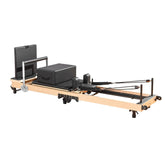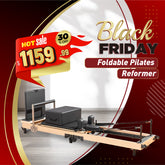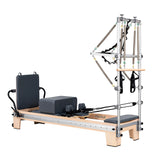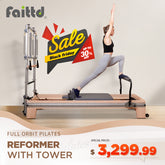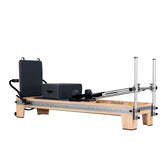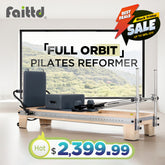What Equipment Do You Need for Pilates at Home?
Ready to start Pilates at home? Let's talk about what you'll need! While you don't have to go all out with equipment right away, having a few key pieces will help you get the most out of your workouts. Think of it like setting up a mini home studio - you'll start with the basics like a good mat and comfy clothes, and maybe add more gear as you progress. The right equipment not only keeps you safe but also helps you nail those moves correctly and really feel the benefits. The best part? You can build your collection over time, starting with just the essentials and adding pieces as your practice grows stronger.
|
Level |
Equipment |
Key Features |
Approximate Cost |
|
Basic (Essential) |
Pilates Mat |
6-10mm thick, non-slip |
$30-60 |
|
Workout Clothes |
Form-fitting, breathable |
$20-50/piece |
|
|
Water Bottle |
20-24 oz, leak-proof |
$10-30 |
|
|
Intermediate |
Resistance Bands |
Set with light/medium/heavy, 5ft+ length |
$15-40 |
|
Magic Circle |
12-14" diameter, 15-20 lbs resistance |
$20-35 |
|
|
Light Weights |
1-3 lbs, neoprene coated |
$10-25/pair |
|
|
Advanced |
4+ springs, 250lb+ capacity |
$2,000-4,000 |
|
|
Stability Ball |
55-75cm, burst-resistant |
$25-50 |
|
|
Foam Roller |
36" length, 6" diameter |
$20-40 |
|
|
Optional Add-ons |
Ankle Weights |
0.5-2 lbs per ankle |
$15-30/pair |
|
Audio Equipment |
Wireless headphones/speaker |
$30-100 |
Why Should You Start Practicing Pilates at Home?
Choosing to practice Pilates in your living space can transform your fitness routine in meaningful ways, offering both practical benefits and personal growth opportunities that studio sessions might not provide. The decision to bring Pilates home opens up a world of convenience while maintaining the effectiveness of this powerful exercise method.
1. Home practice eliminates the common barriers of traditional studio attendance. You'll save money on expensive membership fees and class packages, while also cutting out travel time and transportation costs. This financial and time efficiency makes it easier to maintain a consistent practice.
2. You gain complete freedom over your schedule, enabling you to exercise at your peak energy times - whether that's at dawn, during lunch breaks, or late at night. This flexibility helps you establish a sustainable routine that truly fits your lifestyle rather than forcing yourself to adapt to fixed class schedules.
3. The privacy of home practice creates a judgment-free zone where you can focus entirely on your movements and form. Without the pressure of keeping up with others or feeling self-conscious, you can take the time to perfect your technique and listen to your body's needs.
4. Your home environment gives you total control over your workout conditions. You can adjust the temperature, lighting, and music to your preferences, wear comfortable clothing without dress code restrictions, and customize your space to optimize your practice experience.
5. Working out at home allows you to progress at your own pace, spending extra time on challenging exercises or modifying movements as needed. You can pause to correct your form, repeat sequences, or break down complex movements without feeling rushed by a class timeline.
6. The convenience of having your Pilates space always available means you can split your workouts into shorter sessions throughout the day or easily combine them with other forms of exercise, creating a more flexible and sustainable fitness routine.

What You Need to Get Started with Pilates
Getting into the rhythm of Pilates? Brilliant idea! Actually, you may hardly require equipment to do your pilates routine, yet it is usually important to prepare at least basic stuff to guarantee the level of convenience throughout the exercise.
The Proper Mat Makes Much Difference
This is your magic carpet! You could use a yoga mat, but it's worth investing in a Pilates-specific mat. It's slightly thicker-around the width of your phone-to support your spine while you're doing floor work. Find one that is not too slippery-you want to feel stable while moving through those core-strengthening moves. Make sure it's long enough for you to stretch out fully, too.
Comfy Clothes That Let You Move
Ditch the fancy workout clothes and wear clothes that can provide you with freedom in your movements. Firmly fitting, like leggings or bike shorts, keep well because your form won't distract you. Have a shirt over them that is never going to slide up from these activities—and of course, tug that shirt back into place because you know you want to. And prefer breathable materials as they will give much comfort if the sweat is worked out.
Don't Forget Your Water Bottle
Hydrate, hydrate! Find a water bottle big enough to get you through your workout (20-24 ounces will do), but one that won't spill if you put it down on its side. You don't want to be sloshing water all over the mat, trust me. Any durable water bottle will suffice: stainless steel or plastic. Many people like those that keep their water cold, but that's totally a matter of preference.
Intermediate Equipment for Enhanced Workouts
As you advance in your Pilates journey, incorporating specialized equipment can add new dimensions to your workouts and help target specific muscle groups more effectively. These intermediate tools provide additional resistance and challenge while remaining portable and affordable.
Resistance Bands
Resistance bands add variable resistance to traditional Pilates exercises to help build strength and engagement. Get a set that includes different resistances—light, medium, and heavy—for multiple exercises and progressions. The good bands are at least 5 feet in length and should be made from heavy-duty latex or other similar material that does not snap under tension. Make sure the bands include comfortable handles or loops for a secure grip during exercises. They can also have an ankle attachment option for lower-body exercises.
Magic Circle
The Pilates ring, also known as the magic circle, has provided specific resistive work both for the upper and lower body. This ring usually comes in 12-14-inch diameters, with padded handles for comfort. A good quality ring should be made of flexible yet durable metal or strong plastic that can withstand repeated compression while maintaining its shape. This should feel challenging but manageable; most practitioners find success with rings offering moderate resistance in the range of 15-20 pounds.

Light Weights
Small, 1-3 pound handheld weights enhance Pilates exercises with subtle resistance while maintaining form. The comfortable grip neoprene or vinyl coating prevents slippage during movement. The hexagonal shape does not allow rolling during floor work, while the compact size allows for easy integration into traditional Pilates sequences. Consider starting with one pair of 1-pound weights and work your way up to heavier options as your strength increases.
Advanced Equipment for Serious Practitioners
When you're ready to take your Pilates practice to the next level, professional-grade equipment can provide complex resistance training and enhanced body awareness. These advanced tools require a bigger investment but offer substantial benefits for dedicated practitioners.
Reformer Machine
The Pilates reformer stands as the cornerstone of advanced practice, featuring a sliding carriage, springs, and ropes that create variable resistance throughout movements. Quality home reformers should include at least four springs of different tensions, sturdy frames that support up to 250 pounds, and carriages that glide smoothly without sticking. Professional models typically cost between $2,000 and $4,000 but provide unlimited exercise variations and precise resistance control. Consider models with adjustable headrests, shoulder blocks, and footbars to accommodate different body types and exercise modifications.

Stability Ball
A stability ball challenges core strength and balance while expanding exercise possibilities. Select a ball sized appropriately for your height - when seated, your thighs should be parallel to the ground or at a slight downward angle. Professional-grade balls should be burst-resistant, supporting up to 1000 pounds of pressure, and made from thick PVC material (typically 2mm or thicker). The standard sizes range from 55cm to 75cm diameter, with proper inflation essential for safety and effectiveness.
Foam Roller
A high-density foam roller serves multiple purposes in advanced Pilates, from myofascial release to balance training. Choose a roller measuring 36 inches in length and 6 inches in diameter to accommodate full-body exercises. Professional-grade rollers feature a firm, textured surface that maintains shape under pressure and offers deeper tissue manipulation. Look for ones made from closed-cell EVA foam or EPP foam, which provide durability and maintain firmness even with regular use. Some advanced practitioners prefer rollers with varying surface patterns for different pressure intensities.
Fun Add-ons for Your Pilates Workouts
Want to spruce up your Pilates work? Though you can be sure to do almost anything just as well on the mat alone, there is fun stuff for purchase to enhance the work. Now, take some leg lifts to the task.
Ankle Weights: Add Some Extra Oomph
Looking to make those leg lifts work a bit harder? Ankle weights are your friend! Begin using a half pound to 2 pounds on each ankle. Opt for those that strap on securely with Velcro and are soft, with comfortable padding. The better ones have their weight evenly distributed and not just one chunk of heavy weight so that one can move naturally. They should be fitted but not tight-one should still manage to point and flex his or her feet with ease. Bonus points if they're made from sweat-wicking material to keep you comfortable during upside-down moves!
Music Setup: Set the Mood
The worst thing in the world is tangled cords and dead batteries during a workout. If you work out with headphones, find wireless ones that can keep up with sweat and not fall out of your ears during movements. They should last through several workouts on one charge.
Prefer a speaker? A small Bluetooth one is sufficient—just make sure it's loud enough for your space and the sound is clear. Try to put it at about ear height for the best sound. Some speakers even come with built-in mics, which is super handy if you're following along with online classes or using workout timer apps.
How to Create Your Perfect Home Pilates Space
Before you roll out your mat, let's make sure you have the right spot for your practice. Here's what you need to consider:
- Choose a space that's at least 6' x 8' for mat work, or 10' x 12' if you're planning to use a reformer
- Look for an area with good airflow and natural light, away from household traffic
- Ensure you have a stable floor surface - hardwood or low-pile carpet works best
- Check that your ceiling is high enough for standing exercises
- Pick a spot that stays at a comfortable temperature and offers privacy for focus
How to Keep Your Equipment Organized
Smart storage solutions will help keep your Pilates space tidy and ready for action. Here's how to set it up:
- Install wall hooks or shelves to keep smaller items like resistance bands and magic circles off the floor
- Get a storage bench or cabinet that can double as exercise support while storing your gear
- Keep your most-used equipment within easy reach of your workout area
- Designate specific spots for larger items like reformers or stability balls
- Set up a small cleaning station with disinfectant wipes to keep everything hygienic
- Store equipment away from direct sunlight and dust when not in use
Ready to Start Your Pilates Journey? Let's Do This!
You don't need to have everything at once; starting a home Pilates practice is like building a house: you start with the foundation! First, get yourself a good mat that supports your back, comfortable clothes in which you can move, and a water bottle to keep you going. That's really all you need to begin.
Once you get into the swing of things and feel ready for a little more challenge, you can add in some fun extras like resistance bands or a magic circle. What counts is that you show up for yourself regularly, whether you have all the bells and whistles or just your trusty mat.
